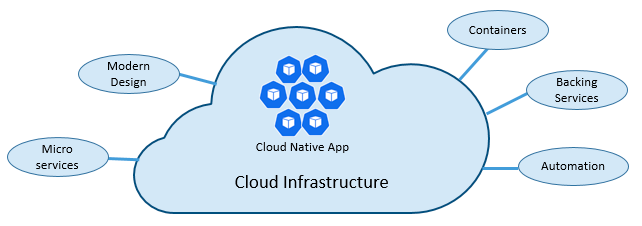Last updated on January 30, 2024
If you could do a quick search on the definition of cloud native, chances are you would be confused by the amount of different sources with varying definitions. The term “cloud native” has become a buzzword within the tech industry, symbolizing a paradigm shift in how software applications are designed, developed, and deployed. But what exactly does cloud native mean?
The varying definitions of cloud native may be primarily because of its evolving definition over time. While some sources define cloud native as an approach where developers initially design applications to thrive in a cloud environment, others emphasize the utilization of containerization is what makes an application cloud native. These definitions, albeit somewhat accurate, merely skim the surface of the true essence of cloud native.
Cloud native, in its most modern definition, is a paradigm. It is an industry standard — an approach to developing, running, and monitoring production-grade applications in modern environments such as the public, private, and hybrid clouds.
Cloud Native Applications
The following are the key characteristics of a cloud native application:
-
Microservices Architecture: Unlike traditional monolithic architecture applications, cloud native applications embrace a microservices architecture. It consists of loosely coupled, interdependent software modules known as microservices. This architecture enhances agility, facilitates modular development, enables independent deployment, and fosters scalable, resilient systems.
-
Containerization and Container Orchestration: Cloud native applications encapsulate their code and dependencies within containers, a process known as containerization. Additionally, an optimized orchestration of these containers ensures seamless deployments and automated scaling.
-
Cloud Computing Design: Cloud native applications should be hosted in the cloud, leveraging the unique delivery models offered only by cloud service providers. The cloud’s scalability, elasticity, and resource optimization enable organizations to manage workloads efficiently, adapt to changing demands, and maximize resource utilization.
-
Adherence to DevOps Principles: The development of cloud native applications upholds DevOps culture and often advocates platform engineering. This collaboration between development and operations accelerates software development, delivery, and operational processes, enhancing the overall velocity and efficiency of software development.
-
Statelessness: Cloud native applications ensure each client-to-server request contains all necessary information for request fulfillment, embodying a stateless design. This statelessness facilitates seamless scaling as applications expand or contract.
-
Infrastructure as Code (IaC) and Immutable Infrastructure Utilization: By employing Infrastructure as Code (IaC) and immutable infrastructures, cloud native applications promote consistency, repeatability, and efficiency in provisioning infrastructure.
-
API Communication: Microservices within cloud native applications communicate via well-defined Application Programming Interfaces (APIs). These APIs maintain clear and concise contracts between services, enabling independent scaling and technological diversity.
-
Observability Incorporation: Cloud native applications integrate built-in logging, monitoring, and analytics to furnish insights into application performance and assist in diagnosing issues.
An application must embody all these characteristics and adhere to these best practices to earn the designation of a cloud native application. Referring back to some earlier definitions, merely hosting an application in the cloud or utilizing containers does not qualify it as cloud native.
An application hosted in the cloud may be a first step towards practicing the cloud native paradigm, but transitioning to a true cloud native approach requires a broader transformation. For example, migrating a monolithic application to a cloud environment does not render it cloud native merely by its new hosting environment.
Furthermore, merely containerizing an application does not give it a cloud native status. Consider that a simple command docker run -p 80:80 -d nginx already launches a dockerized web server. Packaging your application code with this predefined image already deploys a containerized application. While this act encourages your application closer to being cloud native, it alone doesn’t qualify your application as cloud native.
Role of the Cloud Native Computing Foundation (CNCF)
Adhering to the outlined characteristics while crafting a cloud native application may be daunting. Fortunately, the Cloud Native Computing Foundation (CNCF), an open-source subsidiary of the Linux Foundation, exists to ease this process. CNCF nurtures and advances tools, simplifying the creation of cloud native applications while providing support, oversight, and guidance for rapidly evolving cloud native projects. These include renowned tools like Kubernetes, Prometheus, and Envoy.
Today’s tech industry extensively employs CNCF projects to empower various applications by organizations and companies, enabling them to embody the cloud native paradigm. For instance, many have widely adopted Kubernetes as a container orchestration tool, often paired with Helm, its package manager.
Going back to the characteristics of a cloud native application, CNCF offers tools catering to each characteristic. For example, Kubernetes handles container orchestration, while Grafana and Prometheus facilitate observability. Moreover, this organization garners support from the world’s leading developers, users, and substantial vendors, including the big three cloud service providers – AWS, GCP, and Azure.
Conclusion
In conclusion, adopting a cloud native approach is a nuanced and multifaceted process that is beyond merely hosting an application in the cloud or containerizing it. It entails a comprehensive adherence to well-defined characteristics and best practices that shape the anatomy of a cloud native application. These characteristics, coupled with the supporting tools and platforms provided by organizations like the Cloud Native Computing Foundation (CNCF), pave the way for businesses and developers to fully harness the benefits of modern environments. As cloud native continues to evolve as a standard paradigm in the tech industry, its definition may expand or shift, reflecting the continuous innovation in this domain. By staying updated on these evolving practices and leveraging the resources and tools made available by bodies like the CNCF, organizations can navigate the cloud native landscape confidently, ensuring that they remain at the forefront of technological advancement. Through this, they can achieve enhanced agility, scalability, and resilience in their software development endeavors, aligning with the modern-day demands of an increasingly digital and cloud-centric world.
References:
https://aws.amazon.com/what-is/cloud native
https://learn.microsoft.com/en-us/dotnet/architecture/cloud native/definition
https://www.cncf.io/about/who-we-are/



















